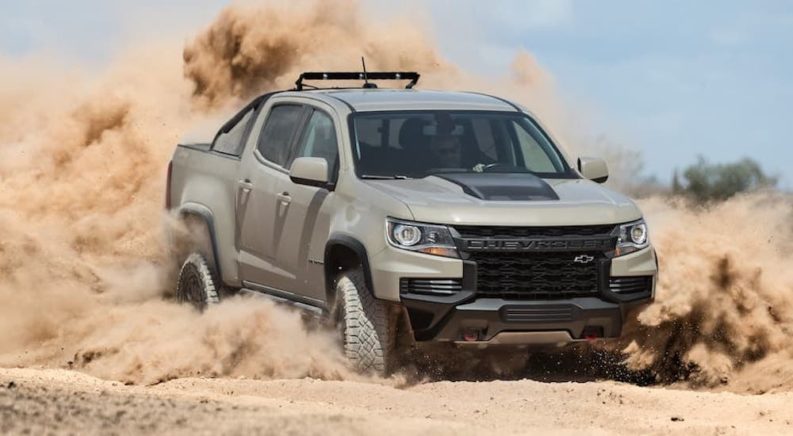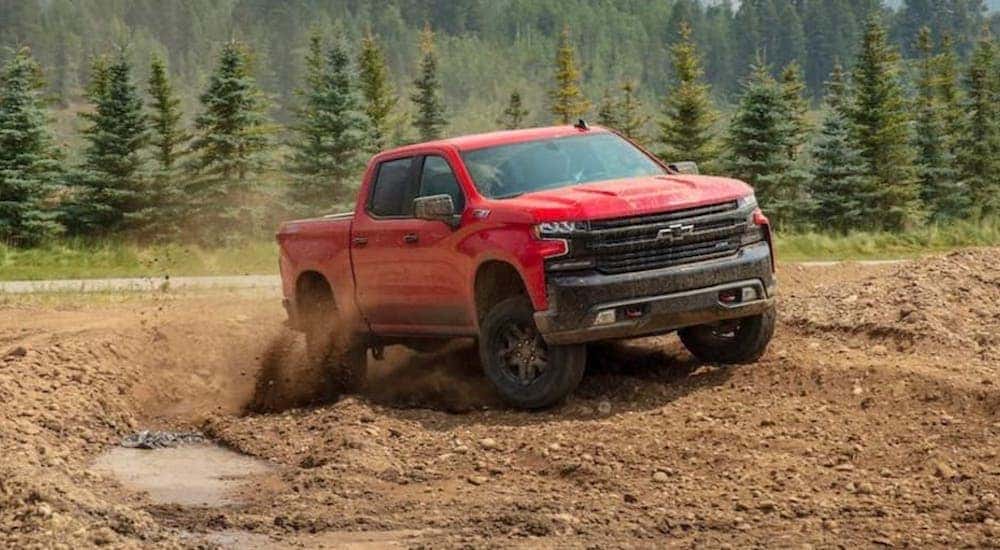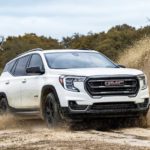Off-roading has exploded in popularity in recent years as drivers seek adventurous outings a little closer to home. The trend has been especially prevalent in the powersports industry, with ATV brands like Polaris reporting a sales boom of more than 40 percent. The auto industry has responded in kind, introducing a slate of new off-road-capable models and trims that allow a new generation of drivers to explore the roads less traveled. However, this new generation may all be full of questions like, “Where do I find off-road tires near me?” and, “Which are the best tires for off-roading?”
At this point, every American automotive brand offers some type of off-road truck or SUV and it seems they’re taking the task seriously. Until recently, all but the upper tier of off-road models were little more than flashy trim packages that offered a whole lot more in the way of form than function: They looked the part, but aside from some heavy-duty fenders, gratuitous body cladding, and new badging, they amounted to little more than reheated versions of existing models. That’s now changing, as automakers integrate some legitimate off-road features into new models, transforming the humble family SUV into a ready-made adventure rig that can scale a 40 percent incline with ease.
As drivers become increasingly drawn to the off-road sector, they’re doing a lot of learning on the fly, figuring out just what makes a good off-road vehicle and customizing their vehicles to fit their own off-road goals. From lifted suspensions and skid plates to winches and locking rear differentials, there’s a lot to study up on. But when it comes to outfitting an off-road vehicle, few components are quite as important as the tires. So, which are the best tires for off-roading? While it largely comes down to a matter of preferences and intended use, there are a few guidelines to follow. Let’s look at what makes a good set of off-road tires, learn the difference between the four major types, and compare some top contenders.
Four Types of Off-Road Tires
A good set of off-road tires are essential for anything but the most casual off-roading. Designed with off-road-specific tread patterns, broad grooves between the tread blocks, and the ability to maintain their grip on a variety of challenging surfaces, they can make the difference between a successful outing and a frustrating afternoon wallowing in the mud. However, “off-road” is actually a pretty general term that encompasses four distinct types of tires: all-terrain, mud-terrain, rock, and sand. While the difference between some of these types can be quite subtle, others are nearly unrecognizable. All-terrain tires provide the best versatility, performing well on a variety of off-road surfaces, but certain applications like rock-crawling or dune-bashing require a very specific set of tires to ensure success.
All-Terrain Tires
If you’re just getting into off-roading and haven’t settled on a specific niche just yet, all-terrain tires are a great place to start. Some of the more purpose-built off-road tires can be a real headache on paved surfaces, generating a rough ride with a lot of noise (and wearing out well before their time). All-terrain tires, meanwhile, provide a happy medium. This makes them ideal for drivers who use their off-road vehicles for everyday driving, allowing them to switch between surfaces without losing out on performance.
All-terrain tires are designed with an open-tread design that improves traction on loose, unpaved surfaces. They also feature reinforced sidewalls, making the tires more puncture-resistance, and use a softer rubber compound that improves flexibility and traction. These attributes allow all-terrain tires to excel when faced with mud, gravel, sand, and rocks but do take a toll on their lifespan; most all-terrain tires are rated to last around 50,000 miles. While all-terrain tires do hold up well in moderate winter conditions, they should not be seen as a replacement for true winter tires, either, as their performance drops way off below the 40°F mark.
Mud-Terrain Tires
For some drivers, it’s just not true off-roading unless you come home caked in mud. If you’re looking to see how much dirt you can kick up, you’ll need a set of mud-terrain tires. These tires feature a more aggressive tread than all-terrain tires, as well as larger blocks and wider channels that prevent the grooves from becoming packed with mud. In fact, even if they do, many mud-terrain tires are designed to efficiently sling mud out of the treads—a sort of built-in self-cleaning function that will mean a whole lot less time chiseling gunk from in-between the grooves.
Mud-terrain tires are grippy and durable, with reinforced sidewalls that help resist punctures from unseen hazards buried in the mud. However, they shouldn’t be seen as an option for everyday driving. Not only are mud-terrain tires noisier and less comfortable than regular all-season tires, but they’re also less stable on wet surfaces. The same attributes that make mud-terrain tires so effective in muddy conditions mean they also perform well in snow, but icy roads are a different story altogether.
Rock-Crawling Tires
Rock-crawling is sort of like the power-lifting of the off-road world: it’s all about high-impact feats of automotive strength over a short time period. The average rock-crawling adventure involves putting your truck or SUV into the lowest gear possible and slowly making your way up a steep, craggy surface—using nothing but 4WD and adrenaline. As such, rock tires occupy their own mini-category in the off-road lineup. While many drivers will simply opt to use mud-terrain tires for rock-crawling applications, there are some rock-specific treads out there for those who insist on using the right tool for the job.
One thing’s for sure: You’ll want a set of tires you can trust, as there aren’t many off-road activities that can go south quite as quickly as rock-crawling. These tires put traction and durability above all else, with extra-large tread blocks and heavy-duty construction that resists cuts and chips. These tires use softer compounds that maximize the contact area between the tire and the rock and feature unique “biting edges” that allow a vehicle to gain traction—even on the bumpiest surfaces.
Sand Tires
There are few off-road activities quite as exhilarating as dune-bashing. While other off-road adventures might involve challenging obstacles or steep, craggy surfaces, dune-bashing allows drivers to put the pedal to the metal and whip around the sand as quickly as they dare. Dune-bashing involves traversing sand dunes at varying speeds while attempting to maintain balance and avoid getting stuck. This requires a very specific type of tire with maximum tread and minimal air pressure, which effectively operates on the same principle as a snowshoe: allowing the tire to cover as much surface area as possible.
While many drivers opt for all-terrain or mud-terrain tires for their dune-bashing excursions, there are two specific types of tires that truly excel in sandy conditions. The first is known as a paddle tire and features V-shaped, paddle-like extrusions along the surface of the tire. Picture the wheel of a paddleboat and you’ll start to get the idea. This design is excellent at churning through sand, but makes them effectively useless on harder or paved surfaces. These are often used solely on the back wheels, as they take too much of a toll on steering when used on all four wheels.
Balloon tires are another option for drivers facing sandy conditions. These are generally some of the widest and lowest-pressure tires on the market and are all about maximizing surface area and traction. Balloon tires can be deflated to operate at as low as 7 PSI and even lower if you choose to invest in a set of beadlock wheels, which will prevent the tire from slipping off the wheel at low pressure.
The Best Off-Road Tires
Best All-Terrain: BFGoodrich All-Terrain T/A KO2
For drivers seeking well-rounded all-terrain tires that can withstand a variety of conditions, look no further than the BFGoodrich’’s All-Terrain T/A KO2. These premium tires might not be the cheapest on the market, but with their ability to tackle everything from mud and rocks to sand and pavement, they’re an exceptional value. The tires have a more aggressive tread design than many of their contemporaries and include cutting-edge technology based on the brand’s own experience in the world of off-road racing.
The All-Terrain T/A KO2 has also been noted for its durability thanks to the use of what BFGoodrich calls Sidewall Armor—and the brand has even gone as far as to include a 50,000-mile warranty to back up the claim. While the tires don’t excel in any one area, their versatility is the biggest selling point, even on paved surfaces. The All-Terrain T/A KO2 performs well on wet, dry, and even snowy paved surfaces—and are just as at home on the highway as they are on the trail. The only drawback is the noise, as these all-terrain tires tend to be a little loud when spinning at highway speeds.
Best Mud-Terrain: Toyo Tire Open Country M/T
While Toyo aren’t generally known for their mud-terrain tires, the Open Country M/Ts have become a favorite of off-road drivers and critics alike since their introduction. The mud-terrain tires feature an aggressive tread pattern and scalloped shoulder blocks that do a superb job of slinging away mud, water, and gravel. This is essential in any mud-terrain tire, ensuring consistent grip while simultaneously preventing uneven wear patterns. The tires might have been designed with mud-slinging in mind, but many of the elements that allow them to excel in the muck also make the tires well-suited for snowy or wet driving conditions.
The scalloped shoulder design and oversized blocks are great at crunching through unpacked snow, though the grip is a bit compromised when it gets packed down. The Open Country M/Ts have also been noted for their ability to withstand hydroplaning: a characteristic not shared by all M/T tires out there.
Best Rock-Crawling: Goodyear Wrangler MT/R with Kevlar
A good rock-crawling tire is all about traction and durability, and when it comes to those two categories, few off-road tires can compete with the Goodyear Wrangler MT/Rs. One of the most durable off-road tires on the market, the Goodyear Wrangler MT/R use the same Kevlar material found in bulletproof vests and body armor to create the ultimate puncture-resistant tires. This design allows them to boast 35 percent better cut and puncture resistance than the competition, meaning you can tackle those rocks as aggressively as your self-preservation instinct will allow.
The Wrangler MT/Rs might come at a premium, but once you factor in their durability, the price tag starts to make a little more sense. In addition to excelling in its rock-crawling duties, the tire is just as suitable for muddy environs, with treads designed to keep the mud flowing out just as quickly as it can flow in. The tires are responsive in both on- and off-road conditions, although responsiveness can start to suffer on wet, paved surfaces. They’re also some of the louder tires you’ll find, meaning the less time spent on the asphalt, the better.
Best Sand: Mickey Thompson Baja ATZ P3
Named after the storied American auto racer who broke the 400-mph barrier—and the location of the world’s most famous off-road desert race—these tires have quite the reputation to live up to, and they certainly deliver. Thompson founded Southern California Off-Road Enthusiasts (SCORE International) in 1973, which is the off-road racing sanctioning body behind the famous Baja 1000 held each year on the Baja California Peninsula.
As one would expect from a set of tires bearing those famous monikers, the Mickey Thompson Baja ATZ P3s are a standout in sandy conditions. Able to float over loose sand and containing durable PowerPly three-ply sidewall construction, the tires were seemingly designed with off-road desert racing in mind. They use a new, proprietary compound to prevent cuts and chips, and feature a series of multi-draft grooves that do a great job of keeping the treads free and clear. The Mickey Thompson Baja ATZ P3s also hold up well in dry or wet paved conditions, though any amount of snow can have a big impact on performance.
Tires might not be the most important part of an off-road setup—I’d probably reserve that honor for four-wheel drive—but they can have a major impact. Knowing what tires you need for your next off-road adventure really comes down to choosing a specialty. While all-terrain tires provide a nice, flexible option for those just starting out, mud, sand, or rock-crawling tires can make all the difference once you find your off-road niche.
Whether you’re prioritizing traction, durability, or control, there’s an off-road tire out there for every application, so make sure you do your research before making a major investment. Your local tire shop or dealership is a great resource and can point you in the right direction, providing expert opinions and first-hand advice pertaining to off-road conditions in your area. You should also consider investing in a spare off-road tire when you go to purchase a set—because last I heard, AAA isn’t great at making service calls in the middle of nowhere.






